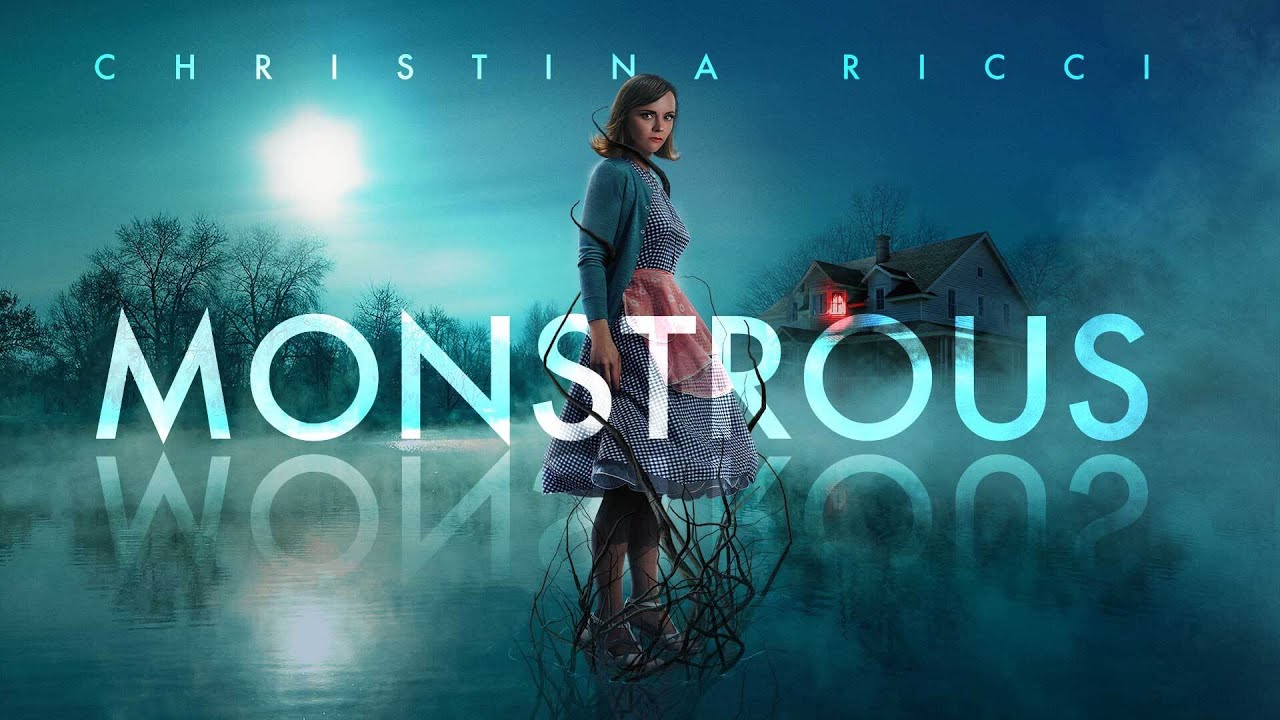
What should be a fresh start for Laura (Christina Ricci) and her son Cody (Santini Barnard) soon becomes a trap. With the past they are running from catching up, and a strange force emerging at night to torment them, there’s nowhere left to run in this tale of trauma and regrets.

Monstrous is a disarming movie that’s content with spending the majority of its runtime setting up a reveal, placing trust in its audience to stick with the journey to get there. Notably, there is a consistent sense of dread throughout, presented through an idyllic period piece that is slightly surreal right from the opening shots and generating perpetual mystery of what is to transpire. Perhaps, “seemingly idyllic” is more apt in exploring the aesthetic, as the cracks soon begin to show as the story turns a picturesque landscape into something more sinister. It’s obvious that something is wrong in the mother and son’s safe haven – perhaps from their past.
Boosting this sense of uncertainty, the dreamlike way scenes are shot can confuse what may or may not be real. Consequently, any supernatural elements that intrude seem more solid than the attempt at the perfect life Ricci’s mother character is desperately attempting to affect. The day-to-day 50’s aesthetic almost always feels dreamlike in a pristine charm, but when the monster does finally emerge, all of this corrodes as a harsh transition. While this paranormal intrusion should be the fantastical element, it instead feels more grounded over the central narrative, somehow more real than pretending everything is dandy. Everything in Monstrous is purposely constructed and built up, even an otherwise jarring day-for-night scene manages to make sense as an interesting stylistic choice once the story payoffs start to kick in. The extreme blue of a day to night shot is deliberately jarring and not a filmmaking compromise – prominently clear once the full context of events is finally known.
Bringing the human element into the production, family drama plays an integral part in building the story. The unknown events of their history, which have led to the family moving dramatically, is a pivotal mystery that drives the denial of Laura’s point of view, and it’s a mirror to all the stranger events which unfold. As the paranormal intrusions escalate, so to do the past events. The revelations of the family’s turbulent history soon begins to mirror the actuality of paranormal activity in interesting ways. As well as being a strong parallel threat, it becomes the main isolating force keeping the family trapped as the intruding paranormal events get worse. It always helps a horror narrative to have a compelling reason to not just flee at the first irrefutable sign of trouble – horror protagonists just staying in clear danger out of curiosity (or plain stupidity) can shatter suspension of disbelief. The tension from having no where else to escape to is pretty adeptly baked in to the plot here, leaving the family no choice other than to face their fears as there is no adequate alternative . There’s even a culmination of this isolation subplot that gives a Ricci a chance to shine with a heart-wrenching breakdown at this sense of being trapped.
The monster design is both visually interesting and well implemented for the story being told. Admittedly, the CGI is a little awkward on the eyes, however. Some practical effects mixed in would have been a welcome addition, but they don’t hinder the overall experience and the design itself is wonderfully conceived. Not to spoil too much, but the origin of the paranormal force, as well as what it may represent, is perfectly teased and kept obscure until the climax–an exemplary case of how effective the less-is-more approach can work and amplify a horror film.

The film is backed by a competent cast, Santini Barnard (Cody) puts in a noteworthy performance, with the young actor approaching his role with the needed nuance to make the story work. Admittedly, his performance comes across as grating at first, toeing the line of a “precocious child” archetype, but everything then snaps into place by the end leaving a favorable impression– it fits well with the overall pace of Monstrous being a slow-burn mystery. Ricci’s performance is strong and layered, remaining in high fidelity to the core of Laura’s journey, but also evolving alongside plot developments to give a compelling many-faceted character study. Bernard is a bit simpler in comparison, something that is more down to the narrative being focused on the mother’s character, the two together make a great team here in showing a dysfunctional family falling apart under an otherworldly assault.
The audience engagement may vary as to how well the slow-burn approach of Monstrous land. Additionally, there is a potential appeal for younger viewers that may empathize with Cody as a child struggling to keep his head above water in a traumatic situation. A wider audience may not really empathise on the same level as a seven year old character, risking scares just not landing on a personal level, although parents should resonate with what Laura is going through as well as the fear of a child being in peril. Outside of these perspectives, there may be limited appeal to those who can’t connect with either. Still, everything works as a solid paranormal drama with emotionally impactful twists, but Monstrous may just not scare some viewers. There is, however, a distinct difference between the adrenaline jolts of jumpscares and the creeping sensations a good psychological horror can leave you with long after the credits roll. If this film is anything, it’s definitely the latter.
Monstrous risks feeling too small in scale to be a feature at times, especially during the long build-up. With so long before revelations really kick in, as well as a small cast using a limited range of locations, there is some risk of viewers losing interest. At times, it could almost feel better suited as part of a television anthology instead of standing alone as a feature. The production value alone does set Mosntrous apart however, not to mention the exemplary performances of Ricci and Bernard, who here manage to carry the subtle moments all the way to the dramatic revelations needed to recontextualise the slow burn into something that was outstanding all along. No matter how innocuous it may seem at times nothing here is a wasted scene, each component is a well-constructed journey to a solid ending everything has been building towards.
Monstrous is well worth tracking down, comfortably able either to be a fun watch alone or as a group movie night. Director Chris Sivertson and writer Carol Chrest’s take on what it is to be haunted confidently stands apart from the usual approaches taken to give a mystery with a satisfying payoff.
MONSTROUS Gets its UK digital release on Monday 11th July, courtesy of Koch Films

More Film Reviews
Box can be called confusing, to say the least. It is a deeply psychological drama with a sheer disturbing quality that could make it easily seen as part of the… The “Alien” movies are some of my favorite creature features to watch. The originalAlien has been so influential as a unique blend of sci-fi and horror that genre outings look to… “In a large isolated cellar, a mysterious aristocratic woman begins torturing a man while videotaping it. The torture escalates as we find out the secrets the man holds inside of… Mas Carnaza is a 1997 Spanish splatter horror short, written and directed by Sergio Blasco. No stranger behind the camera, Sergio is known for also writing and directing the shorts… Slasher Horror With a Conscience It’s no secret that as a society, we have become obsessed with serial killers. The most popular podcasts and television series over the past decade… Having a roommate can be hard. Whether it’s disrespect of the kitchen cleaning rules or failing to remember how thin the average bedroom wall is, living with another person is…Takashi Miike’s Box (2004) Film Review: A Brilliant Voyage Into the Murky, Uncertain Elements of the Mind
Double Film Review: In the Cinemas, No One Can Hear You Miss Out on ‘LIFE’, ‘UNDERWATER’
Xpiation (2017) Film Review – Strap in for Some Good Old Fashioned Torture
Mas Carnaza (1997) Film Review – Mass Carnage
Random Acts of Violence (2019) – Film Review
2LDK (2003) Film Review – Killer Co-habitation in the Tiny Rooms of Tokyo

Luke Greensmith is an Editor at the Grimoire of Horror and an active folklorist as well as working in film across a few roles. While this can cover quite a wide range of things, he’s a dedicated horror fan at heart and pretty involved with horror communities both online and local to him. You can find their folklore work on the Ghost Story Guys Podcast, their own LukeLore podcast, and accompanying the artist Wanda Fraser’s Dark Arts series as well as on the Grimoire of Horror itself.





